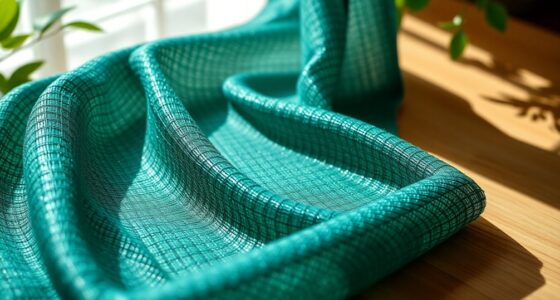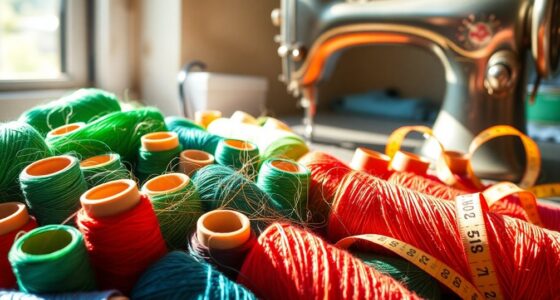Barbie's materials have evolved considerably, moving from traditional PVC to modern eco-friendly plastics like recycled ocean-bound materials. Early designs relied on phthalate-based plasticizers for flexibility, but safety regulations shifted the focus toward durable options like LDPE and EVA. Alongside aesthetic innovations, Barbie embraces sustainability by using water-based paints and bio-based materials. This transformation keeps her styles iconic while addressing modern environmental concerns. Explore how these changes reflect fashion trends and cultural significance in Barbie's journey.
Key Takeaways
- Barbie's original materials included PVC, which evolved to incorporate safer and more durable plastics like LDPE, ABS, and EVA over time.
- Recent collectible Barbies utilize silkstone, enhancing their aesthetic appeal while reflecting fashion trends and societal changes.
- Modern Barbies emphasize sustainability by using recycled ocean-bound plastics and eco-friendly materials in their production.
- The design process incorporates advanced technology, with computer-assisted design ensuring precision and craftsmanship in Barbie's iconic styles.
- Barbie's diverse fashion lineup promotes inclusivity, showcasing various cultural identities through the materials and designs used.
The Evolution of Barbie's Materials
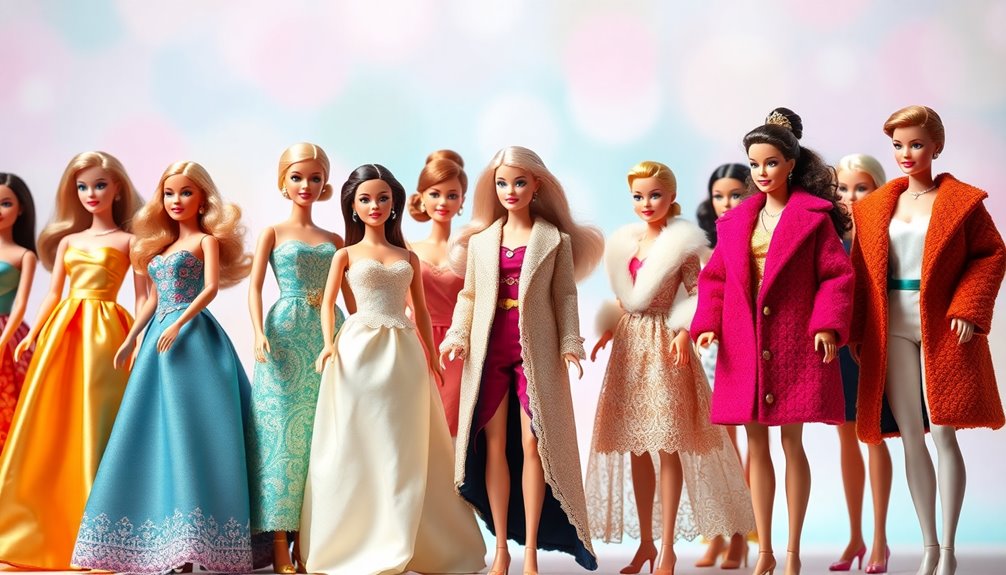
As Barbie evolved over the decades, so did the materials used to create her iconic dolls. Initially, Barbie was crafted from molds, which allowed for intricate designs and lifelike aesthetics. With technological advancements, 3D design software transformed how Barbie was conceived, enabling detailed visualizations and simulations. The global demand for Barbie dolls posed challenges in scaling production efficiently while adhering to safety regulations. In the 1980s, changes in safety laws, particularly in Europe, prompted shifts in material composition. Concerns over PVC's environmental impact led to newer, safer formulations and recyclable plastics. Today, Barbie's materials feature a complex mix, blending durability with playability, ensuring her status as a beloved toy remains intact while embracing sustainability. Furthermore, the evolution of materials reflects the changes in manufacturing practices, particularly the transition from primarily PVC to a diverse mix of plastics. Additionally, the move towards sustainable plastics is essential for addressing environmental concerns associated with toy production.
From PVC to Modern Plastics
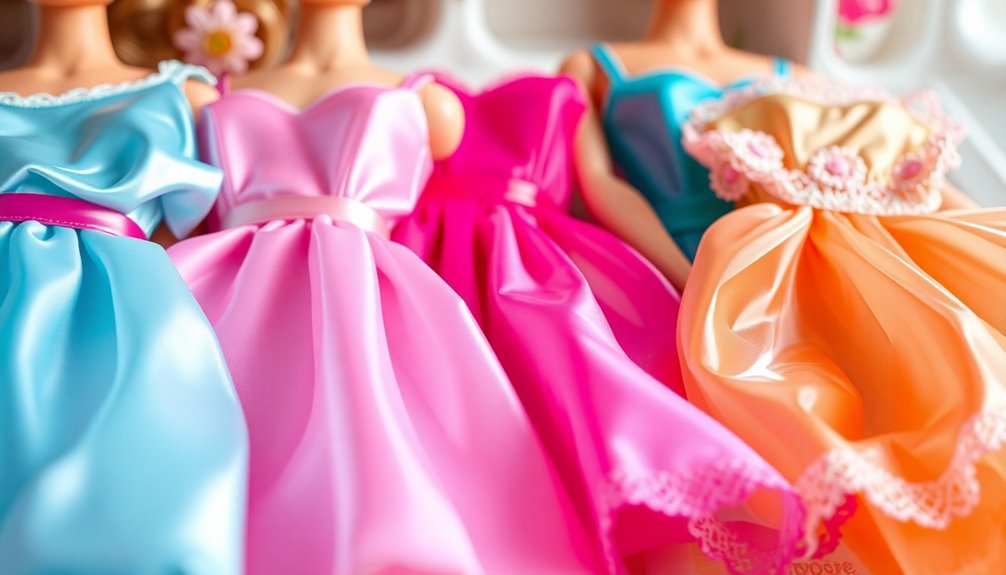
Barbie's journey from PVC to modern plastics showcases the toy industry's adaptability to changing safety standards and environmental concerns.
Early dolls primarily used polyvinyl chloride (PVC), enhanced with phthalate-based plasticizers for flexibility. However, these materials deteriorated over time, prompting regulatory changes. As a result, Barbie evolved to incorporate low-density polyethylene (LDPE), acrylonitrile butadiene styrene (ABS), and ethylene-vinyl acetate (EVA) for improved durability and realism. Recent collectible Barbies feature silkstone, a polyester-based plastic, which further enhances their aesthetic appeal and durability.
Modern Barbies also feature recycled ocean-bound plastics and elastomers for joint flexibility. The focus on sustainability has led to the use of water-based paints and polyester-based materials. This shift highlights the commitment to creating iconic dolls while addressing environmental impacts and embracing innovative materials in production.
Manufacturing Techniques Behind Barbie Dolls
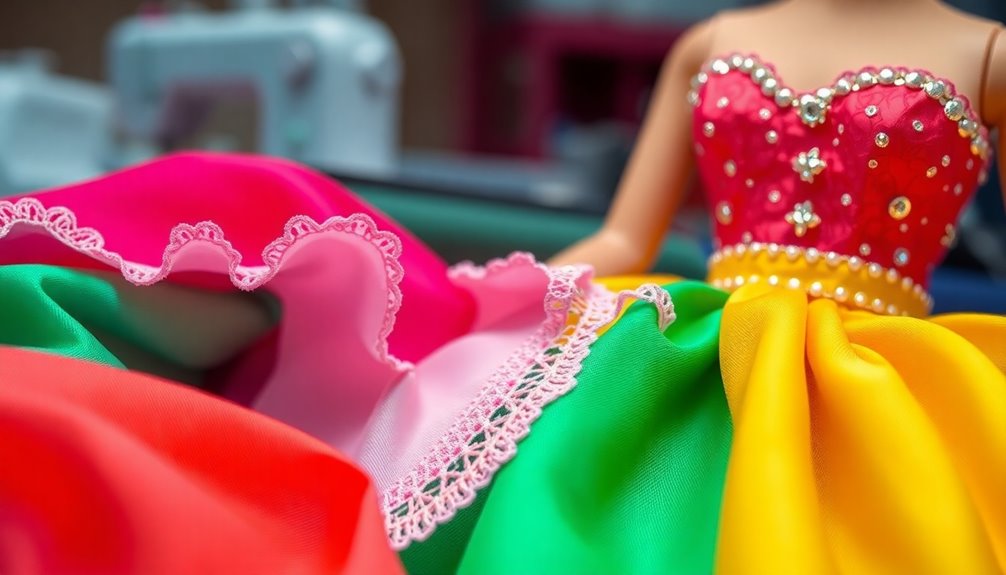
The manufacturing techniques behind Barbie dolls reflect a blend of innovation and tradition, ensuring each doll meets high standards of quality and playability.
You'll find that rotation moulding plays an essential role, allowing vinyl to harden uniformly without leaving incomplete parts. While injection moulding was initially used, it faced challenges with filling all cavities.
Different plastics like EVA, ABS, and PVC are strategically selected for various doll components. Modern processes, including computer-assisted design, enhance precision for joints, while synthetic fibers like Saran are sewn in for hair. Additionally, the introduction of diverse body types in the new line has further influenced the selection of materials and manufacturing techniques.
Eyes and makeup are hand-applied, emphasizing craftsmanship. Accessories feature miniaturized zippers, and clothing is meticulously sewn, showcasing a commitment to detail in every doll you collect.
The Impact of Fashion Trends on Barbie
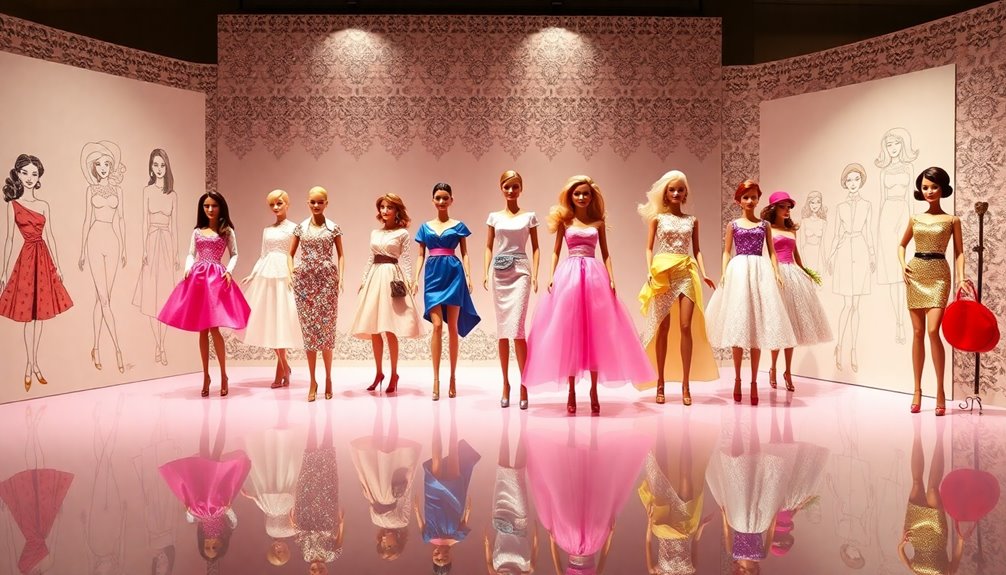
While fashion trends evolve rapidly, Barbie remains a powerful influence in the industry, shaping styles and attitudes around femininity.
The Barbiecore trend, characterized by vibrant pinks and feminine silhouettes, has swept the globe, inspiring celebrities like Lizzo and Florence Pugh to showcase its charm. High-end brands such as Valentino have embraced this trend with all-pink collections, further solidifying Barbie's impact. Major brands have also released Barbie-inspired collections, showcasing the widespread influence of this iconic doll. Additionally, the popularity of Nike Tech in sneaker culture highlights how modern consumers are merging comfort with vibrant aesthetics in their fashion choices.
Accessories like pink plastic purses and platform shoes have surged in popularity, making waves in both high fashion and street style.
Barbie's diverse fashion lineup promotes inclusivity, encouraging a broader dialogue about gender norms and cultural identity.
Ultimately, Barbie's evolution reflects societal changes, making her a timeless symbol of style and self-expression.
Addressing Environmental Concerns in Production
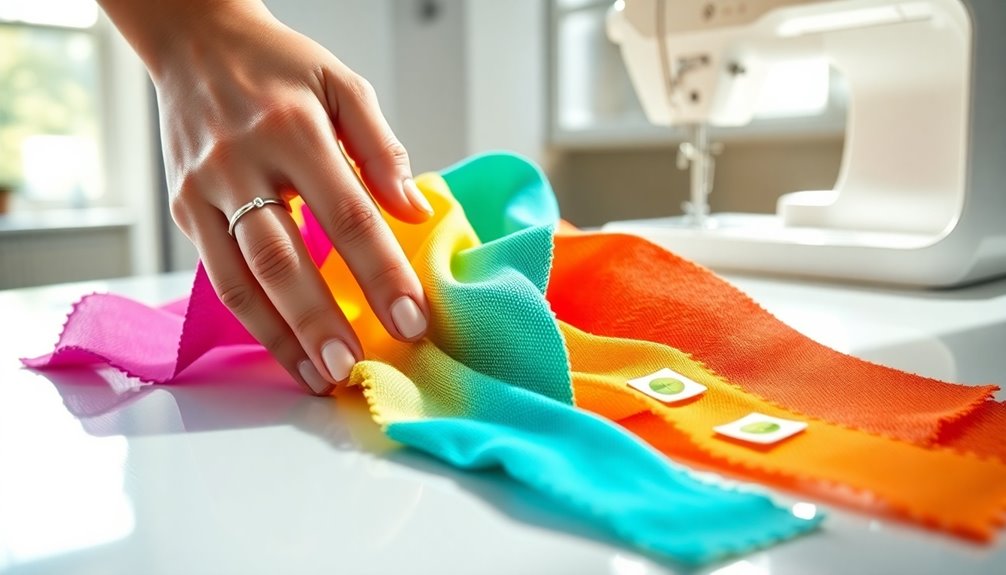
As consumers become more environmentally conscious, toy companies like Mattel face increasing pressure to address the environmental concerns tied to Barbie production.
With around 60 million Barbie dolls produced annually, the plastic waste and greenhouse gas emissions are staggering. Each doll contributes roughly 648g of CO2e, equating to 3.4 million metric tons of CO2 generated from production and transportation.
The reliance on plastics like PVC and ABS leads to long-lasting pollution, breaking down into microplastics that persist for centuries.
In response, Mattel has pledged to use 100% recycled or bio-based plastic by 2030 and encourages toy recycling.
However, shifting to sustainable materials poses challenges, and authenticity is vital for maintaining consumer trust and brand loyalty.
Cultural Significance of Barbie Through the Years
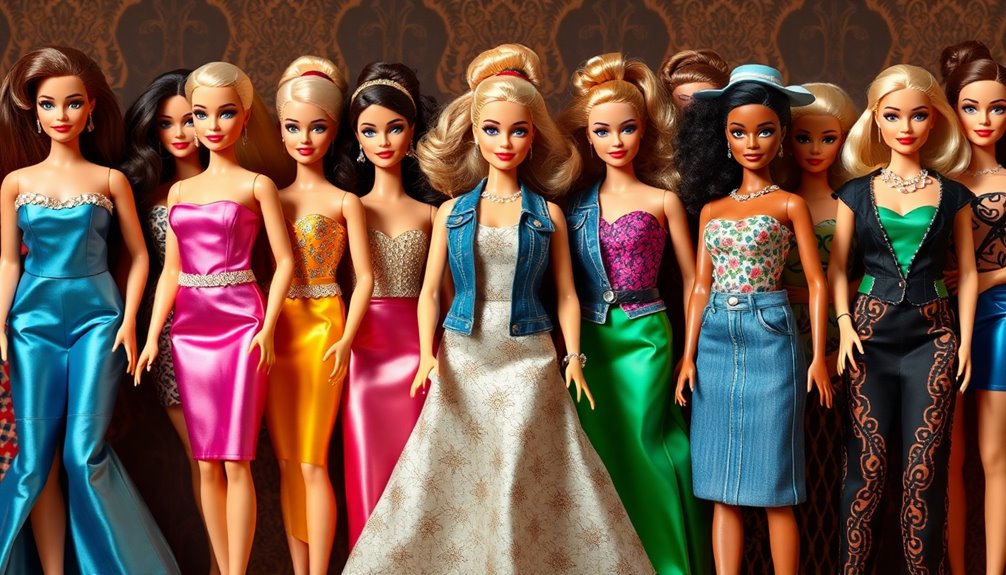
Shifting from the pressing environmental concerns surrounding Barbie's production, it's important to recognize the doll's profound cultural significance throughout the decades.
Since her debut in 1959, Barbie's been a cultural icon, symbolizing beauty, fashion, and empowerment. Reflecting the latest trends, her outfits have influenced generations, shaping perceptions of style and identity in children. In the 1960s, Barbie embraced the mod look with mini-skirts and go-go boots, showcasing the changing styles of the time.
Emerging in a post-war context, Barbie represented a shift in gender roles, moving women toward more autonomous identities. With each evolution, she mirrored societal changes, from materialism to inclusivity.
Today, Barbie continues to inspire self-expression, promoting diversity through her varied representations.
Ultimately, Barbie's enduring legacy encapsulates the evolving norms of femininity and cultural values, making her a significant artifact of history.
The Future of Barbie Materials and Sustainability
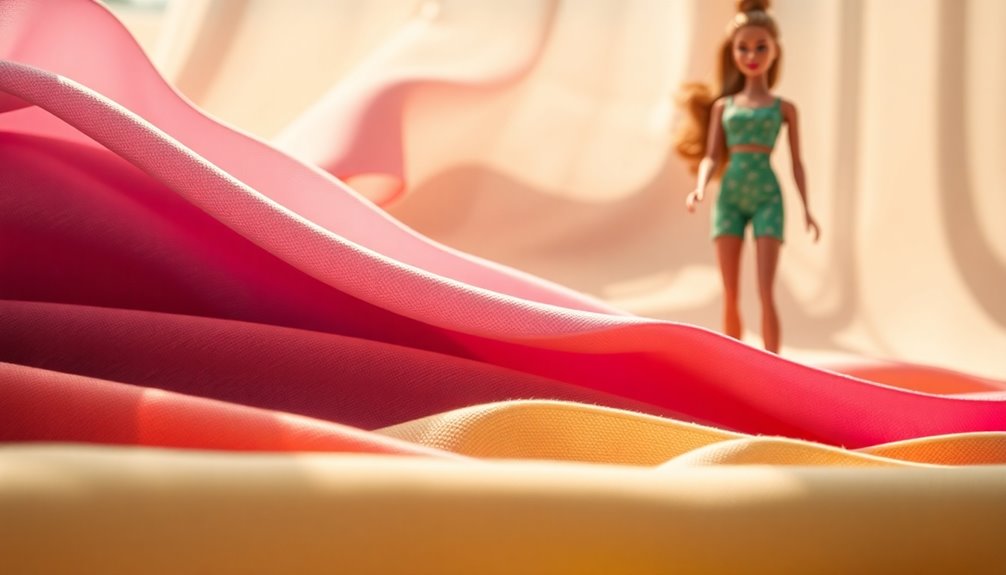
With a growing emphasis on sustainability, the future of Barbie materials looks promising as Mattel embraces innovative practices to reduce its environmental footprint.
You'll see Barbie dolls made from bioplastics derived from renewable resources like cornstarch and sugarcane, cutting down on environmental impact. Some dolls even use recycled ocean-bound plastic, tackling plastic waste directly. Additionally, eco-conscious manufacturing processes ensure that Mattel's production methods contribute to a healthier planet. Furthermore, using recycled materials not only promotes sustainability but also aligns with industry trends toward environmentally responsible practices.
By 2030, Mattel aims to achieve 100% recycled, recyclable, or bio-based materials. Eco-friendly packaging and printed clothing details make waste reduction easier.
Plus, Barbie now showcases careers focused on sustainability, inspiring young minds. Through partnerships and community initiatives, Mattel fosters environmental awareness, positioning Barbie as a role model for future generations committed to sustainability.
The future of Barbie is bright, and you can be part of it!
Frequently Asked Questions
What Safety Standards Are Barbie Dolls Required to Meet?
Barbie dolls must meet several safety standards to guarantee they're safe for kids.
You'll find that they comply with the Consumer Product Safety Improvement Act, which tests for toxicants like lead and cadmium.
Toys for children under 12 need third-party testing and certification.
Additionally, you'll notice choking hazard warnings on playsets with small parts, guaranteeing parents are aware of potential risks for younger children.
These regulations help keep playtime safe and enjoyable.
How Are Barbie Dolls Tested for Quality Control?
Did you know that over 90% of toys, including Barbie dolls, undergo rigorous testing before hitting the shelves?
To verify quality control, you'll find that Barbie dolls are subjected to drop tests for durability, and their materials are assessed for stress and flexibility.
The joints are also tested for integrity, while surface finishes are inspected for consistency.
All these steps help guarantee a safe and durable toy for endless playtime adventures!
What Are the Most Popular Barbie Materials Used Today?
Today, the most popular materials used for Barbie dolls include various plastics like PVC and ABS, ensuring durability and flexibility.
You'll also find eco-friendly options, such as recycled ocean-bound plastics in the Barbie Loves the Ocean collection.
For clothing, over 105 million yards of fabric have been utilized, with designers sketching on muslin.
Additionally, water-based paints give Barbie a vibrant and eco-conscious finish, reflecting modern sustainability trends.
How Does Barbie's Material Choice Affect Playability?
Barbie's material choice greatly enhances playability.
When you play with dolls made from flexible materials, like EVA, you notice smoother movement and a more realistic feel. This flexibility allows for dynamic poses, making your play scenarios more engaging.
Plus, the softer texture adds to the tactile experience, making it enjoyable to handle.
Are There Any Limited Edition Barbie Dolls With Unique Materials?
Imagine unearthing a treasure chest filled with rare gems; that's what collecting limited edition Barbie dolls feels like.
Yes, there are many limited edition Barbie dolls featuring unique materials. For instance, the Barbie Loves the Ocean collection uses recycled ocean-bound plastic, making them eco-friendly.
Additionally, dolls in the Dolls of the World series showcase traditional fabrics from various cultures, creating a vibrant tapestry of stories and styles that collectors cherish.
Conclusion
As Barbie evolves, the materials she embodies reflect not just fashion, but the changing world around us. Each fabric choice symbolizes a step toward sustainability, echoing our collective journey towards a greener future. Just like Barbie herself, you have the power to shape the narrative—embracing innovation while honoring tradition. By choosing wisely, you can help transform the fabric of our society, weaving a vibrant tapestry that celebrates both style and responsibility. Together, let's stitch a brighter tomorrow.


